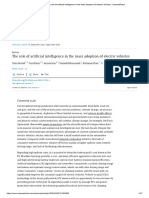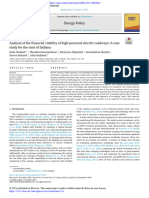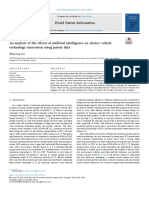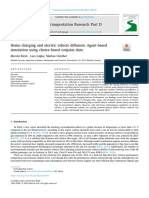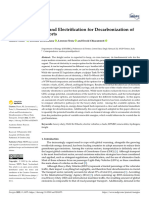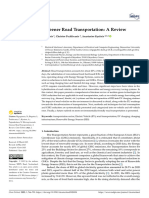Vehicle To Grid
Vehicle To Grid
Uploaded by
Greeshma PuttannaCopyright:
Available Formats
Vehicle To Grid
Vehicle To Grid
Uploaded by
Greeshma PuttannaOriginal Title
Copyright
Available Formats
Share this document
Did you find this document useful?
Is this content inappropriate?
Copyright:
Available Formats
Vehicle To Grid
Vehicle To Grid
Uploaded by
Greeshma PuttannaCopyright:
Available Formats
Integration of the Vehicle to Grid Technology
INTEGRATION OF THE VEHICLE TO
GRID TECHNOLOGY
Submitted by: Under the guidance of:
GREESHMA P
1BI16EE018 Dr. H B NAGESH
Associate Professor
Dept. of EEE, BIT
ABSTRACT- With the increasing pollution level and environmental threats,
the 21st century is moving towards green and sustainable like plug-in hybrid
electric vehicles. They have vast scope and capabilities of energy storage. This
feature of vehicles is making them to utilize for energy storage and distribute/sell
it during 'peak' demand. The vehicle to grid (V2G) technology with some
improvement may present a promising solution for future energy problems. The
features, applications and advantages of V2G are presented. Many programs by
automotive industries, power generation units and government of different
countries are being performed to make V2G technology viable for future use.
I. INTRODUCTION
Increasing pollution level and global warming are the major areas of
concern as the era head deeper into the current century. Emissions of greenhouse
gases, carbon dioxide (CO2), carbon monoxide (CO), nitrogen oxides (NOx) and
unburned hydrocarbons (HCs) in large amount have caused environmental
pollution and global warming. A lot of these emissions are caused for the
fulfilment of the basic human requirements such as electricity production,
transportation, industrial and commercial purposes [1].
Dept. of EEE, BIT 2019-2020
Integration of the Vehicle to Grid Technology
The modern transport sector relies on the internal combustion engine based
vehicles which use petroleum to propel the vehicle and emit toxic gases;
ultimately causing harm to the environment and human life [2]. Eventually, there
has been a search for a more efficient and clean vehicle. Due to the continuous
decreasing level of fuel and energy resources, hybrid and plug-in hybrid electric
(PHEVs) vehicles are in the spotlight for quite a while now. They are being seen
as the future of transportation with combustible fuel resources depleting fast.
Owing to the need of efficient electric drive systems and consumer interest in
PHEVs, major automotive manufacturers began launching PHEVs in 2010. The
number of PHEVs has grown over the years and the stored on-board energy in
the electrical storage systems (ESS) can be harnessed to provide additional
functionalities. Most of the customer-owned vehicles stay parked more often than
they are driven. This offers an opportunity to utilize their stored energy while
they are idle. The predictions reveals that, the vehicle fleet can contribute up to
two-thirds of the forecasted peak load [5].
Since the ESS on board in an electric vehicle allow two way power flow, they
can be used to take power from or supply power to a connected grid. The Vehicle-
to-Grid (V2G) concept stands on this principle. It describes a system in which
plug-in electric vehicles communicate with the power grid when not in use and
provide power to the grid during peak power requirements and get charged from
the grid during off peak hours. The fundamental idea is to set up an exchange
system between the grid and a vehicle with electrical energy storage capabilities
to benefit both the parties involved [3-4].
The applications of V2G are vast and provides a wide array of possibilities for
reliable power generation and storage. V2G also promises a more sustained
approach where the environment is also a major concern.
Dept. of EEE, BIT 2019-2020
Integration of the Vehicle to Grid Technology
2. REFERENCES
1. United States environmental protection Agency, “Sources of
greenhouse gas emissions”,
http://www.epa.gov/climatechange/ghgemissions/sources.html.
2. A. Panday and H. O. Bansal, "Green Transportation: Need,
Technology and Challenges", Int. J. Global Energy Issues, Inderscience
publishers, Vol. 37, No. 5/6, pp. 304-318.
3. A. Briones, J. Francfort, P. Heitmann, M. Shey, S. Shey and J. Smart,
“Vehicle-to-grid (V2G) power flow regulations and building codes
review by the AVTA”, INL/EXT-12-26853, September 2012.
4. A. Ashouri, M. J. Benz and L. Guzzella, “Comparing control
strategies for EV and PHEV fleets providing regulation ancillary
services”, 2012 IEEE Int. Conf. Control Applications, Dubrovnik,
Croatia, October 3-5, 2012, pp. 739 - 744.
5. R. Sioshansi and P. Denholm, “The value of plug-in hybrid electric
vehicles as grid resources”, Energy Journal , vol. 31, no. 3, paper no.
01/2010.
6. A. B. Rolufs, "Kansas City Plug-In Electric Vehicle Demonstration
Project", Missouri Transportation Institute, Missouri university of
science and engineering.
Dept. of EEE, BIT 2019-2020
You might also like
- Innovation Landscape brief: Electric-vehicle smart chargingFrom EverandInnovation Landscape brief: Electric-vehicle smart chargingNo ratings yet
- IeeesiteDocument6 pagesIeeesiteAshish VoraNo ratings yet
- 426 The Role of Electrification of Transport in The EnergyDocument15 pages426 The Role of Electrification of Transport in The EnergyMoses kabeyiNo ratings yet
- The Role of Artificial Intelligence in The Mass Adoption of Electric Vehicles - ScienceDirectDocument47 pagesThe Role of Artificial Intelligence in The Mass Adoption of Electric Vehicles - ScienceDirectc b joshiNo ratings yet
- MarwaDocument34 pagesMarwadhpthuNo ratings yet
- I Eee SiteDocument6 pagesI Eee SitenishantchippaNo ratings yet
- R2-Analysis of The Financial Viability of High-Powered Electric RoadwaysDocument15 pagesR2-Analysis of The Financial Viability of High-Powered Electric Roadwaysvermasaab.220No ratings yet
- Projected Transistion On EVDocument12 pagesProjected Transistion On EVshreya pariharNo ratings yet
- Artigo 07 ADocument10 pagesArtigo 07 ALucas BerraNo ratings yet
- WilleyDocument26 pagesWilleyDebasree SahaNo ratings yet
- 1 s2.0 S2352484722001068 MainDocument8 pages1 s2.0 S2352484722001068 MainXavier JosephNo ratings yet
- (EN) Jurnal Infrastruk EV Charging Stations-MainDocument16 pages(EN) Jurnal Infrastruk EV Charging Stations-MainTeddy MaulanaNo ratings yet
- Tech. SeminarDocument8 pagesTech. Seminar7rxbgwtffhNo ratings yet
- Reaping The Benefits of Smart Electric Vehicle Charging and Vehicle-to-Grid Technologies Regulatory Policy and Technical AspectsDocument16 pagesReaping The Benefits of Smart Electric Vehicle Charging and Vehicle-to-Grid Technologies Regulatory Policy and Technical AspectsRshishabh YadavNo ratings yet
- The Rise of Electric VehiclesDocument6 pagesThe Rise of Electric Vehicleskotisekhan10No ratings yet
- 1 s2.0 S1364032122001344 MainDocument18 pages1 s2.0 S1364032122001344 MainJulius RojoNo ratings yet
- Internet of Things Enabled Electric Vehicles in Smart CitiesDocument8 pagesInternet of Things Enabled Electric Vehicles in Smart Citiespushpa lathaNo ratings yet
- Storage Technologies For Electric Vehicles: SciencedirectDocument22 pagesStorage Technologies For Electric Vehicles: Sciencedirectnikhil naniNo ratings yet
- Low Emission Scenarios With Shared and Electric Cars Analyzing Life Cycle Emissions Biofuel Use Battery Utilization and Fleet DevelopmentDocument20 pagesLow Emission Scenarios With Shared and Electric Cars Analyzing Life Cycle Emissions Biofuel Use Battery Utilization and Fleet DevelopmentUmar CarlitozNo ratings yet
- Rev 242176 Data Detective ProjectDocument7 pagesRev 242176 Data Detective ProjectDavid KosgeiNo ratings yet
- Factors Influencing Adoption of Electric Vehicles A Case in IndiaDocument22 pagesFactors Influencing Adoption of Electric Vehicles A Case in IndiaPuneet GirdharNo ratings yet
- 3 Electric-vehicles-development-in-Sub-Saharan-Africa - Performa - 2022 - Journal-ODocument24 pages3 Electric-vehicles-development-in-Sub-Saharan-Africa - Performa - 2022 - Journal-OMohammad Ashifur RahmanNo ratings yet
- Transportation Engineering: Sonali Goel, Renu Sharma, Akshay Kumar RathoreDocument14 pagesTransportation Engineering: Sonali Goel, Renu Sharma, Akshay Kumar RathoreIgoor Morro MelloNo ratings yet
- InglesDocument41 pagesInglesGatososodNo ratings yet
- Evaluation of Electric Vehicle Component Performance Over Eco-Driving CyclesDocument17 pagesEvaluation of Electric Vehicle Component Performance Over Eco-Driving CyclesPawan DhakalNo ratings yet
- 1 s2.0 S1364032122001344 MainDocument17 pages1 s2.0 S1364032122001344 MainSteven ChuadinataNo ratings yet
- Overview of Plug-In Electric Vehicle Technologies: K.Ramalingam and C.S.IndulkarDocument21 pagesOverview of Plug-In Electric Vehicle Technologies: K.Ramalingam and C.S.Indulkarpratap68No ratings yet
- 001 - Barriers To EV Adoption - EVidence From IndiaDocument19 pages001 - Barriers To EV Adoption - EVidence From IndiaJordan PetersonNo ratings yet
- Electrical Vicheles Benefits Challengs and PotentialDocument24 pagesElectrical Vicheles Benefits Challengs and PotentialAmiroNo ratings yet
- Fuel Cell Electric Vehicle Characterisation Under Laboratory and in Use OperationDocument13 pagesFuel Cell Electric Vehicle Characterisation Under Laboratory and in Use OperationalexandmagaraNo ratings yet
- A Review On Electric Vehicle and Its ChargingDocument6 pagesA Review On Electric Vehicle and Its ChargingInternational Journal of Innovative Science and Research TechnologyNo ratings yet
- Factors Influencing Adoption of Electric Vehicles A Case in IndiaDocument22 pagesFactors Influencing Adoption of Electric Vehicles A Case in IndiaaachuashnajudeNo ratings yet
- Environmental Science and Pollution Research3 PDFDocument18 pagesEnvironmental Science and Pollution Research3 PDFbrf1365No ratings yet
- HahahahaDocument14 pagesHahahahaBudussy EaterNo ratings yet
- CBC Dan Agent Based SimulationDocument20 pagesCBC Dan Agent Based Simulationkomang nickitaNo ratings yet
- A Quadratic Programming Based Optimisation To Manage Electric Bus Fleet Charging - HoubbadiDocument20 pagesA Quadratic Programming Based Optimisation To Manage Electric Bus Fleet Charging - HoubbadiIvana BlackNo ratings yet
- 1 s2.0 S0030402622014048 MainDocument8 pages1 s2.0 S0030402622014048 Mainamjadpervez04No ratings yet
- Electric Cars: Technical Characteristics and Environmental ImpactsDocument15 pagesElectric Cars: Technical Characteristics and Environmental Impactssunil_arizonaNo ratings yet
- Environmental Impact Assessment ReviewDocument13 pagesEnvironmental Impact Assessment ReviewmahasiswaNo ratings yet
- Evaluation of Barriers To Electric Vehicle AdoptioDocument19 pagesEvaluation of Barriers To Electric Vehicle Adoptioriskypriscil.careerNo ratings yet
- Battery in GeneralDocument16 pagesBattery in GeneralFalah AlhajriNo ratings yet
- Applsci 10 06590Document10 pagesApplsci 10 06590Minh VõNo ratings yet
- Energies 16 00895 v2Document18 pagesEnergies 16 00895 v2Parama DwityaNo ratings yet
- Modelling of Life Cycle CostDocument14 pagesModelling of Life Cycle CostYousef SalehNo ratings yet
- CESifo Forum 2018 4 Appl Scorza Lippelt Littlejohn Electrification DecemberDocument4 pagesCESifo Forum 2018 4 Appl Scorza Lippelt Littlejohn Electrification DecemberMahabub HaiderNo ratings yet
- 10 35378-Gujs 554206-1121835Document19 pages10 35378-Gujs 554206-1121835Nahil ShakerNo ratings yet
- International EV Standards PDFDocument25 pagesInternational EV Standards PDFNishit ParmarNo ratings yet
- Overview of Electric and Hybrid VehiclesDocument8 pagesOverview of Electric and Hybrid VehiclesdanielyismawNo ratings yet
- Why Is Electric Vehicle Not Booming in IndiaDocument6 pagesWhy Is Electric Vehicle Not Booming in IndiaIJRASETPublicationsNo ratings yet
- Energies 14 01939 v2Document24 pagesEnergies 14 01939 v2Chandrasekaran NNo ratings yet
- Jpee 2022072114404937Document12 pagesJpee 2022072114404937Pundlik KalghatgiNo ratings yet
- Optimization EV For Long TripDocument17 pagesOptimization EV For Long TripJegan RamNo ratings yet
- Electric Vehicles and Charging Infrastructure in Turkey An OverviewDocument15 pagesElectric Vehicles and Charging Infrastructure in Turkey An OverviewkemredserbiaNo ratings yet
- Vehicle-To-Grid Systems For Sustainable DevelopmenDocument19 pagesVehicle-To-Grid Systems For Sustainable DevelopmenkarthicktamilmaniNo ratings yet
- Chapter 4 PDFDocument48 pagesChapter 4 PDFjeevan singh100% (1)
- 6 - Transportation ElectrificationDocument98 pages6 - Transportation ElectrificationNamiraNo ratings yet
- Energies Journal - Comparison of E-FuelsDocument17 pagesEnergies Journal - Comparison of E-FuelsBilal AhmadNo ratings yet
- Cleantechnol 05 00038Document25 pagesCleantechnol 05 00038Jovana NikolicNo ratings yet
- Electric Cars: Technical Characteristics and Environmental ImpactsDocument16 pagesElectric Cars: Technical Characteristics and Environmental ImpactsAnugrah SasindranNo ratings yet
- Electric Vehicles Unveiled: Navigating the Benefits and Challenges of Going ElectricFrom EverandElectric Vehicles Unveiled: Navigating the Benefits and Challenges of Going ElectricNo ratings yet
- ICT 30s Model On Steroids 1Document20 pagesICT 30s Model On Steroids 1hamuNo ratings yet
- HuronDocument8 pagesHuronCatawba SecurityNo ratings yet
- Social Network Addiction PresentationDocument12 pagesSocial Network Addiction PresentationAfaq AhmedNo ratings yet
- NMF CV 03 23 23 PDFDocument6 pagesNMF CV 03 23 23 PDFNathanNo ratings yet
- Festo - FittingsDocument14 pagesFesto - FittingsNo HopeNo ratings yet
- N50 Implen NanoPhotometer Data SheetDocument2 pagesN50 Implen NanoPhotometer Data SheetZhang NickNo ratings yet
- TESDA - Program Registration Forms Land-BasedDocument26 pagesTESDA - Program Registration Forms Land-BasedBobby Olavides SebastianNo ratings yet
- ENDO Orise Gel Brochure English ENDO-644702-AA DINEND2413EADocument3 pagesENDO Orise Gel Brochure English ENDO-644702-AA DINEND2413EABashir AlsirawanNo ratings yet
- IEA Vs BSADocument12 pagesIEA Vs BSAhtc DmnNo ratings yet
- Spec - Iso - FloorDocument11 pagesSpec - Iso - FloorcokiaaNo ratings yet
- Templates Package 1 ContentDocument1 pageTemplates Package 1 Contentسيلفا سيلفاNo ratings yet
- E-Ticket 0706658136310: Kolkata BhubaneswarDocument2 pagesE-Ticket 0706658136310: Kolkata BhubaneswarBanerjee SuvranilNo ratings yet
- Assignment HR Audit SKMDocument6 pagesAssignment HR Audit SKMAiman BegNo ratings yet
- NX58H9500WS Stove Manual PDFDocument76 pagesNX58H9500WS Stove Manual PDFcgrigorasNo ratings yet
- Machine Learning in NewDocument13 pagesMachine Learning in NewViralmonsterNo ratings yet
- Report PPM Sakai Triputra Group by An (130623) ..Document6 pagesReport PPM Sakai Triputra Group by An (130623) ..mauNo ratings yet
- Bram Cor EQUIPO DE PRE TRATAMIENTO Biopharma Water SystemsDocument16 pagesBram Cor EQUIPO DE PRE TRATAMIENTO Biopharma Water SystemsYeimer MesaNo ratings yet
- Digital Circuits: EE/CE 3320 / Spring 2020 / Lecture 12Document82 pagesDigital Circuits: EE/CE 3320 / Spring 2020 / Lecture 12Muhammad MontahaNo ratings yet
- Economics Real Life ExamplesDocument22 pagesEconomics Real Life ExamplesachinthaNo ratings yet
- 1 A Model For Process Equipment Damage Probability Assessment Due To LightningDocument9 pages1 A Model For Process Equipment Damage Probability Assessment Due To LightningENRIQUENo ratings yet
- Kingdom of Saudi Arabia: Marshall Asphalt Mix Design DataDocument1 pageKingdom of Saudi Arabia: Marshall Asphalt Mix Design DataHamza AldaeefNo ratings yet
- Active Realty Vs DaroyaDocument4 pagesActive Realty Vs DaroyajessapuerinNo ratings yet
- Esg Reporting Guide enDocument28 pagesEsg Reporting Guide enSalah Eddine100% (2)
- Analysis of Grain SizeDocument12 pagesAnalysis of Grain SizecortellaptopNo ratings yet
- Basics Using Matlab Fuzzy ToolboxDocument65 pagesBasics Using Matlab Fuzzy Toolboxdieu_ag2No ratings yet
- Literature ReviewDocument4 pagesLiterature Reviewapi-549248807No ratings yet
- Camalco Bauxite Product Technical SpecificationDocument1 pageCamalco Bauxite Product Technical SpecificationnovaNo ratings yet
- Is.13054.1991 0 PDFDocument8 pagesIs.13054.1991 0 PDFRakesh MishraNo ratings yet
- M100-10RK (81369 LectroCount Retrofit) PDFDocument1 pageM100-10RK (81369 LectroCount Retrofit) PDFLazzarus Az GunawanNo ratings yet
- Advanced Engineering Economics For Engineer Managers: Mcgraw-Hill/IrwinDocument27 pagesAdvanced Engineering Economics For Engineer Managers: Mcgraw-Hill/IrwincamilodomesaNo ratings yet



